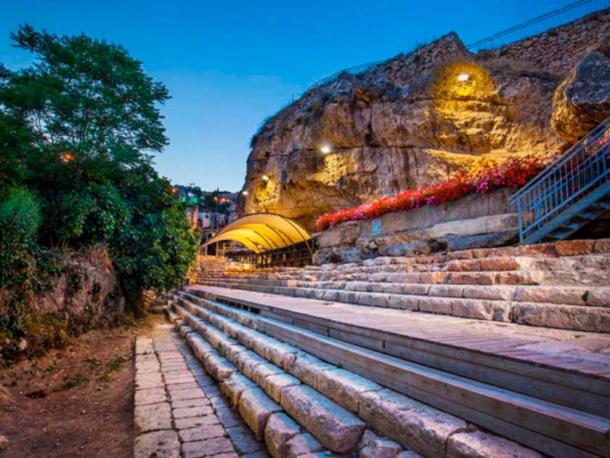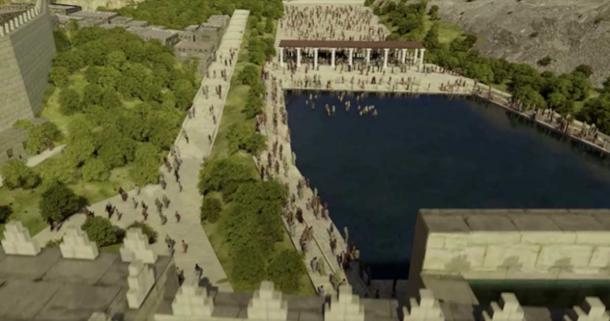The Israel Antiquities Authority (IAA) has announced that the 2,700-year-old Pool of Siloam, which is believed to have been used as a ritual bath by the ancient residents of Jerusalem, will be fully excavated over the coming months. In addition to its significance in Jewish history, this location is also well-known to Christians, as it was at the Pool of Siloam where Jesus was said to have restored the sight of a man born blind.
“The Pool of Siloam in the City of David National Park in Jerusalem is a site of historic, national and international significance,” said Jerusalem’s Mayor Moshe Lion, in a press release published on the Israeli government’s Ministry of Foreign Affairs website . “After many years of anticipation, we will soon merit being able to uncover this important site and make it accessible to the millions of visitors visiting Jerusalem each year.”
Work on the excavation project will be sponsored by the City of David Foundation, an organization that supports tourism, education, archaeological expeditions, and land purchases in areas of East Jerusalem that are predominantly occupied by Palestinians.
Parting the Waters of the City of Jerusalem in the Siloam Tunnel of King Hezekiah

The Story of King Hezekiah and the Pool of Siloam Project
The Pool of Siloam is located in the Palestinian village of Silwan, just outside the perimeter of the Old City of Jerusalem. It is entirely manmade, having been constructed during the reign of the Israelite King Hezekiah in the eighth century BC. When it was in use the Pool of Siloam was fed by the waters of the Gihon Spring, which were transported to the reservoir through the fortified Siloam Tunnel .
Hezekiah was known for financing an array of infrastructure construction projects during his time as the leader of the Kingdom of Judah , and he was especially determined to maintain Jerusalem’s access to fresh water supplies should they be attacked by Judah’s enemies (most notably the Assyrians). The Pool of Siloam was built within the city limits of the original Jerusalem, as a protected site that would not be vulnerable to seizure by outside invaders.
The water in the Pool of Siloam was not reserved exclusively for drinking. The Pool was used for religious ceremonies and ritual purification, beginning in Hezekiah’s time and continuing up through the Second Temple period (516 BC to 70 AD). Pilgrims who arrived during the latter period were encouraged to purify themselves in the pool’s sacred waters before entering the holy city, which they did willingly.
The Pool of Siloam construction project is specifically mentioned in the Bible.

“Now the rest of the acts of Hezekiah, and all his might, and how he made the Pool, and the conduit, and brought water into the city, are they not written in the Book of Chronicles of the kings of Judah?” the Bible ask rhetorically, in passage 20:20 from the Book of Kings II.
This is not the only written confirmation that establishes Hezekiah’s role in building the famed pool. In 1880, archaeologists exploring the site unearthed an inscription in ancient Hebrew that basically told the same story as the Biblical reference. It described how the Siloam Tunnel and Pool were constructed, once again dating these acts to the reign of the legendary King Hezekiah. This inscription is believed to have been made at the time the project was completed, and it is currently on display at the Istanbul Archaeology Museum in Turkey (although talks are underway that could result in it being returned to the Israeli cultural authorities).
And as perhaps the last piece in the puzzle, archaeologists claim to have found a further inscription in the tunnel which specifically states Hezekiah was responsible for the building of the tunnel .
Will the Pool of Siloam Excavations Be Controversial? Stay Tuned
The steps leading down to the Pool of Siloam were fully excavated for the first time in the 1960s by British archaeologist Kathleen Kenyon. She performed her work at a location that had actually been discovered in the 1890s, by a group of British and American archaeologists who visited the site and uncovered a few of the pool’s steps.
Over the years, other parts of the area around the pool have been excavated by archaeologists from around the world. But the new project will focus on fully exposing the entire pool, which up to now has remained mostly hidden. Only the northern perimeter and small section of the eastern perimeter of the pool have been exposed so far, as a result of excavations carried out in 2004. In total the pool is estimated to cover about 1.25 acres, or one-half of one hectare of space.
The site of the excavated pool will be added to a “Pilgrims Route” that begins at the edge of the Western Wall and terminates at the southern border of the City of David site, which is considered to be the earliest Jewish settlement in Jerusalem.
Notably, much of this territory is within the current borders of the Palestinian village of Silwan . It is not yet known whether Palestinians living in Silwan will be open to the new round of excavations, or what type of arrangements might be made to secure their cooperation. The involvement of the City of David Foundation, which actively supports the movement of Jewish-Israeli settlers into Palestinian-occupied neighborhoods, may make it difficult to negotiate any type of agreement. But it seems the project will be carried out regardless of any objections that might be raised.
The IAA announcement didn’t specify when the excavations would be complete. But the City of David Foundation did say the site would be open to the public throughout the process, starting immediately.
Top image: A CGI representation of the Pool of Siloam as it once would have been. Source: Israel Antiquities Authority Screenshot
By Nathan Falde
Source: www.ancient-origins.net





